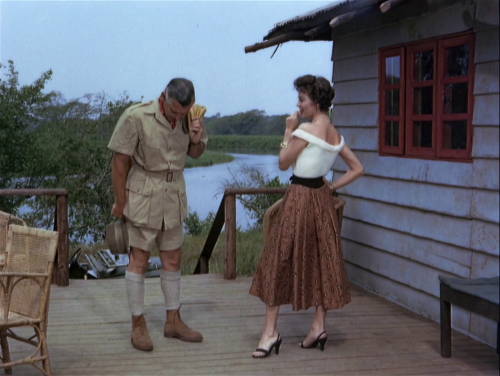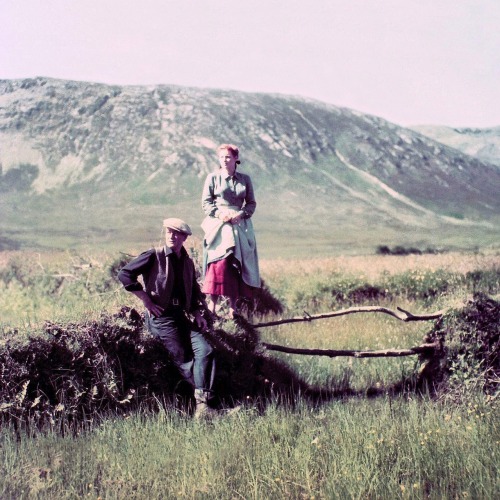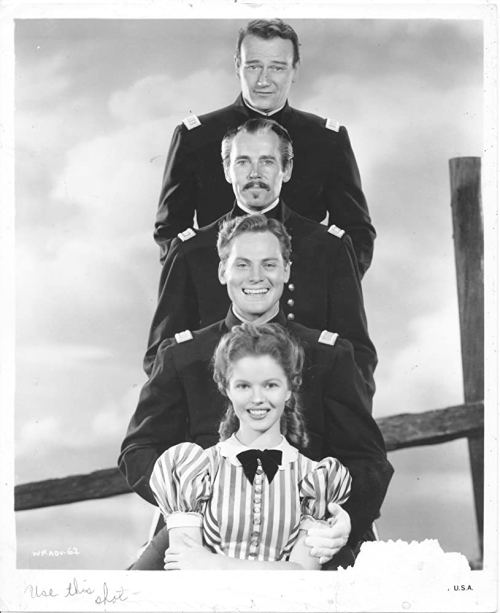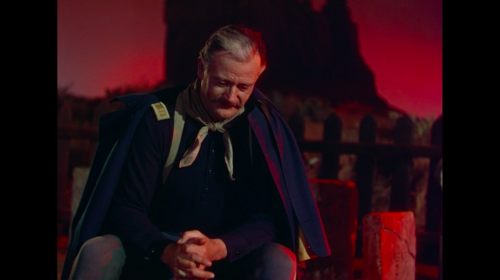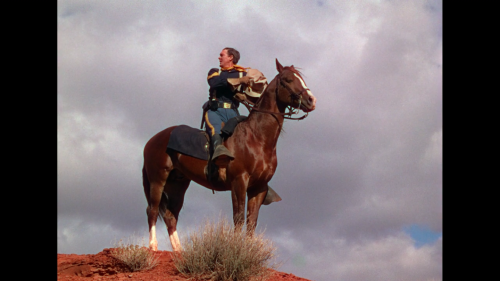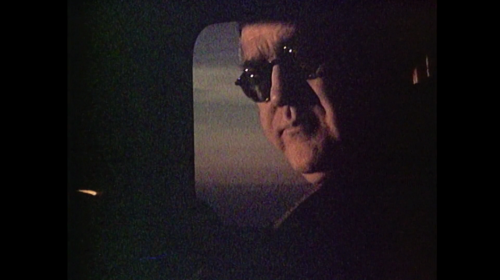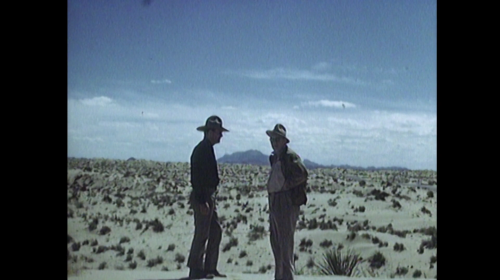#john ford
Peter Bogdanovich about John Ford:
He once said to me: [does gruff John Ford voice] “Jesus Christ, is that all you can do is ask questions? You’ve never heard of a declarative sentence?
Post link

Yo heave ho, anchors aweigh, and we’ll steer a course for Joe’s place. And just to show that me heart’s in the right place, I’ll tell you what I’ll do, mates. I’ll extend a drink all around.
Crimp-The Long Voyage Home(1940)
Fort Apache (1948) production still. I up-scaled and “refreshed” the picture.
Top to bottom: John Wayne,Henry Fonda,John AgarandShirley Temple.
Post link

It opens with a chase. An unnamed criminal is being pursued by a uniformed officer and a detective, John “Scottie” Ferguson, across the rooftops of San Francisco. As the criminal and officer jump over a ledge, Scottie misses and slides down the roof, somehow managing to grab hold of a gutter to prevent his fall. This is the moment he realises he has vertigo, otherwise known as a crippling, debilitating fear of heights. As the officer tries to help him, he overstretches and falls off the roof while Scottie can only hang there helplessly. The scene fades, and we never see how Scottie gets down.
This is the beginning of Alfred Hitchcock’s Vertigo, the most beguiling work of the great director’s career. More pertinently, this enigmatic sequence shows Hitchcock starting as he means to go on: brutally, mysteriously, and, above all else, improbably.
Set in 1950’s San Francisco, Hitchcock’s 1958 classic follows John “Scottie” Ferguson, a detective forced into early retirement due to his aforementioned fear of heights. After he’s privately hired by an old college friend to follow his allegedly possessed wife, Scottie becomes embroiled in a bizarre web of deceit that causes his life to spiral wildly out of control.
To say the production of Vertigo was fraught with difficulty would be redundant; it boasted more twists and turns than a typical Hitchcock narrative. Hitchcock had been trying to obtain the screenplay rights to Pierre Boileau and Thomas Narcejac’s novel Celle qui n'était plus, translated as The Woman Who Was No More (the novel chronicles the efforts of two womenworking in a boarding schoolto kill their abusive boss, until one of them double crosses the other) but lost out to Henri-Georges Clouzot, allegedly by a matter of hours. From this novel, Clouzot made Les Diaboliques, a film that drew positive comparisons to Hitchcock on its release in 1955, as well as one that’s now regarded as a classic of the suspense genre. Paramount, knowing that Hitchcock had a keen interest to make a film based on the work of the two authors, bought the rights to their 1954 novel D'Entre les morts before it had even been translated into English, with the intention of having the director adapt it. This adaptation would eventually become Vertigo. But making the film wasn’t as easy as simply giving Hitchcock a screenplay and have him make the film. Far from it.
In all, three writers were hired to work on the film at various stages of the production: Maxwell Anderson, Alec Coppel and Sam Taylor. Anderson, a playwright by trade who had received a joint screenplay credit for Hitchcock’s 1956 film The Wrong Man, was initially hired to write a treatment of the novel, but Hitchcock didn’t like it, and hired Alec Coppell to reinterpret the story and work on the first draft of the script. Coppel, another playwright and Oscar nominated screenwriter for Anthony Kimmins’ The Captain’s Paradise in 1953, delivered the first draft of the script without dialogue, as he had other contractual commitments. Hitchcock and Paramount asked Anderson to write the dialogue for the script, but he refused and pulled out, so a third writer, Sam Taylor, was hired to finish the script. Taylor would be the writer who, following the departures of Coppel and Anderson and the later hospitalisation of Hitchcock for a hernia operation, took control of the script, adding dialogue and revising the scenes written by Coppel. He submitted the finished screenplay to Paramount in September 1957; three years after the studio secured the rights to the novel.
But this was only the start of the problems. In the course of these delays, lead actress Vera Miles, due to play the dual-role of Madeleine Elster/Judy Barton, was forced to pull out after she fell pregnant. After he had lost his usual female lead, Grace Kelly, in 1956 following her marriage to Rainier III, Prince of Monaco and subsequent retirement from acting, Hitchcock needed a new female collaborator. Following her performance in John Ford’s The Searchers (1956), Hitchcock signed Miles on a five-year personal contract with the intention of shaping her into a star (an ironic parallel with the story of Vertigo). However, following her pregnancy, Hitchcock all but abandoned is efforts with Miles, casting her as Lila Crane, a supporting character in 1960’s Psycho,and sporadically in his TV series. He said of the situation, in an interview with Francois Truffaut: “She became pregnant just before the part that was going to make her a star. After that, I lost interest; I couldn’t get the rhythm going with her again.” Her pregnancy and falling out with Hitchcock forced the director to look elsewhere for his lead actress, reluctantly hiring Kim Novak for the part. He told Truffaut: “Miss Novak arrived on the set with all sorts of pre-conceived notions that I couldn’t possibly go along with”, hinting at the difficult relationship between the two.

Eventually,Vertigowas finished, but Hitchcock still had reservations – particularly about a scene about two thirds of the way through the film in which Judy confesses to her part in the murder of Madeleine. This scene removes the mystery from the film before the climax that, considering Hitchcock is known for his twist-endings and sustained mystery, is an unusual decision. Of this, Peter Bradshaw, film critic of The Guardian, says: “The “reveal” is troubling to some, and perhaps they would have preferred Hitchcock to have found a way of deferring this disclosure so that it happens near the end and in the dramatic present tense. But in revealing the truth relatively early, Hitchcock creates a new kind of suspense – the suspense of wondering what on earth Judy is going to do.” This is true, and envisaging Vertigo without this premature reveal removes much of what makes it so great. Charles Barr, author of the BFI Film Classics analysis of the film, suggests that this reveal is “a shrewd addition”, writing: “without the revelation, the script becomes oppressively weighed down at the end with retrospective material, an anguished going over of past events”. Hitchcock still thought that this scene wouldn’t work and, following the first preview screenings, he demanded it be taken out. On hearing this, Paramount demanded that the scene be put back in, and Hitchcock, again reluctantly, obliged.
When the film was finally released, it didn’t receive the fanfare that Hitchcock had hoped for, both critically and commercially. The New York Times called Vertigo“devilishly far-fetched”, while Variety labeled it as “prime though uneven Hitchcock”. In Britain, The Sunday Times’ Dilys Powell suggested that Vertigo“seems too long, too elaborately designed; the narration of this kind of criminal intrigue sags under such luscious treatment;it needs the touch of the harsh and squalid”, and Sight & Sound’s Penelope Houston suggested that many scenes in Vertigowere“reminiscent of things Hitchcock has done before, and generally done with more verve”, and that Hitchcock seemed to be “repeating himself in slow motion”.
Hitchcock’s disappointment in Vertigo’s initial failure is apparent in his comments to the press, stating on numerous occasions that it lay in his casting of 50-year-old James Stewart as Scottie as a love interest for Kim Novak who, at age 25, was half Stewart’s age. In Hitchcock’s mind, as Stewart looked too old the romance was too far-fetched for the audience to invest in. This criticism strained the once fruitful professional relationship of Hitchcock and Stewart, who made four films together (Rope(1948),Rear Window(1954),The Man Who Knew Too Much (1956), and finally Vertigo), and the two never worked together again, with Hitchcock preferring Cary Grant as the lead for his next film, North By Northwest (1959), despite James Stewart being the original choice for the part.
To shroud the film in even more mystery, the film virtually disappeared for a number of years, when a clause in his contract allowed Hitchcock to remove Vertigo from circulation in the early 1970’s, allegedly as a financial contingency plan for his family, along with four other films (Rope,Rear Window,The Man Who Knew Too Much and The Trouble With Harry (1955)). Following Hitchcock’s death in 1980, the films were available for release again, after much legal and financial wrangling. In 1983, Vertigo was re-released in cinemas to rapturous acclaim, both critically and commercially. This re-evaluation saw the film selected for preservation by the National Film Registry of America 1989, as well as being inducted into the US Library of Congress in the same year. It was also voted into three successive Sight and Sound Critics Top Ten polls: it placed in joint seventh in 1982 (with Orson Welles’ The Magnificent Ambersons (1942) and Antonioni’s L’Avventura(1960)), fourth in 1992, and second in 2002 (behind Welles’ perennial winner, Citizen Kane), and it currently sits in eighth place in the Cahiers du Cinema Top 100. It also earned another cinematic re-release in 1996.
So what happened in the twenty-five between its disappointing initial release and its almost belated critical re-appraisal? Time, it seems, truly does make the heart grow fonder.

The contemporaneous re-evaluation of Vertigo hasinvited various different interpretations from many different sources, but one thing that everyone seems to agree on is that Vertigo is something of an anomaly in Hitchcock’s expansive filmography. To borrow a phrase from theorist and director Chris Marker’s essay A Free Replay (Notes on Vertigo), Vertigois“both typically and untypically Hitchcockian”. The idea that a film can be both separate to and a part of a director’s body of work is an interesting one, especially for Hitchcock, who certainly didn’t earn the moniker of “The Master of Suspense” by directing comedies. Martyn Glanville, former critic of the BBC, explains the differences between Vertigo and Hitchcock’s earlier films: “Madness (Rebecca (1940), Psycho) and duplicity (Dial M For Murder (1954), Rope, Foreign Correspondent (1940)) are common themes in Hitchcock’s work but, in these films and most others, there is what I can only characterise as an entertainment, much like how Graham Greene called his popular fiction “an entertainment” compared to his literary fiction. For me, Vertigo is more of a drama about clinical depression told through the framework of a thriller, and not simply entertainment from a thrilling set-up that one might expect from Hitchcock.” Peter Bradshaw adds: “My own feeling is that Vertigo appeals to those who adore Hitchcock’s evocation of obsession, danger and madness, but prefer to favour a movie which appears classier or more upscale than, say, the pulp masterpiece Psycho.” Hitchcock’s departure from well-constructed entertainment to a more stylish and classy form of a thriller would explain Vertigo’s poor initial reception, as audiences were expecting the more traditional entertainment that Hitchcock was known for, rather than the violently emotional and complex film that Vertigois.
These differences are hinted at in Marker’s suitably cryptic statement, which not only captures the relationship between Vertigo and the other films in Hitchcock’s extensive oeuvre, but introduces the conflict at the centre of the film; the idea of doubles.
Hitchcock had experimented with doubles, duos and reflections in his films before Vertigo, notably Shadow of a Doubt (1943), in which Joseph Cotten’s seemingly mild mannered Uncle Charlie is actually a jewel thief wanted for murder, and Strangers on a Train (1951), in which two men (Farley Granger and Robert Walker) with problematic people in their lives plot to swap murders (“criss-cross”) to commit the perfect crime. When one man goes through with the plan and the other doesn’t, he double crosses the innocent man in an attempt to frame him.
But Hitchcock had never examined this theme more explicitly than he did in Vertigo.The aforementioned Kim Novak plays two roles in the film, Madeleine Elster, the troubled wife of Scottie’s college friend Gavin Elster, and Judy Barton, a shop girl with an uncanny likeness to Madeleine – enough to pique the interests of the emotionally damaged Scottie following Madeleine’s death. This doppelgänger effect is the drive of the film, yet the majority of the film’s detractors suggest that this premise is too preposterous to sustain it. To refer back to the aforementioned review from the New York Times, the film is “devilishly far-fetched”. Even Hitchcock had his reservations about the believability of the story, telling Truffaut: “One of the things that bothers me is a flaw in the story. The husband was planning to throw his wife down from the top of the tower. But how could he know that James Stewart wouldn’t make it up those stairs? Because he was dizzy? How could he be sure of that!” What he says is true, and this is something of a hole in the story.
But inconsistencies in its plot don’t offer a true reflection of Vertigo, a film that in many ways jumps out of Hitchcock’s filmography as something completely different, something bold, and yet simultaneously something so typically Hitchcockian that it couldn’t have been made by any other filmmaker. Hitchcock said, again to Truffaut, that “the story [of Vertigo] was of less importance to [him] than the over-all visual impact on the screen”, and it’s in the visual impact that Vertigo really comes into its own.
Shot in Technicolor on VistaVision, a high-resolution, widescreen film stock, and later restored to a 70mm print (even higher resolution), Vertigo is the most lavish of Hitchcock’s films – importantly so, as much of Vertigo’s exquisite artistry stems from the director’s use of colour. A lot of directors in the 1940’s and 50’s began to adopt colour in their films, and although it’s not his first film in colour (Rope, nine years earlier, was), Hitchcock’s use of it in Vertigo is instrumental to his study of sexual obsession. Greens and reds, representing a multitude of emotions – red for romance, passion and danger; green for envy, sickness and death; all of which are entrenched within the film – burst from the screen, particularly during the first scene in Ernie’s. Having built an exact replica of the famous San Francisco restaurant in a Paramount studio, Hitchcock covered the walls in the vivid red wallpaper that lines the walls of the real Ernie’s and dressed the extras in black suits and quiet dresses, while Kim Novak, the centre of the scene, is dressed in a lavish green coat over a long, gorgeous black dress. As she sashays past the onlooking James Stewart, he can’t take her eyes off her. At this moment she’s the object of his desire, and his obsession is born.

Much of the impact of this moment stems from the beauty of Kim Novak, and the array of Edith Head designed costumes she is dressed in throughout the film: the grey dress-suit she wears first as Madeleine and later as the newly transformed Judy, the green ensemble she wears as Judy when Scottie follows her to her hotel, and the black dress Judy wears to the restaurant, and her death, after Scottie transforms her. Novak excels in the dual-role, imbuing Vertigo with much of the emotional depth that sets it apart from the other, comparatively cold films of Hitchcock’s filmography.
Of course, this performance is equalled, if not surpassed, by that of James Stewart, playing against type as the mild mannered detective come mentally unstable obsessive. His performance resembles that of Fred MacMurray in Billy Wilder’s Double Indemnity (1944), an everyman actor playing a character radically different to how audiences were used to seeing him, driven to the brink by the surreptitious actions of an illicit lover. The difference being that Stewart brings a huge amount of emotion to his role – which is necessary for the film to work as well as it does – while MacMurray is not required to. Stewart’s performance is near-flawless, crafting Scottie as a truly innocent, almost childlike man (“Oh gee-whiz”), and making his fall from grace all the more tragic and unsettling.
The culmination of his Frankenstein-like transformation of Judy into Madeleine is, in particular, emotionally devastating. After forcing her to change her appearance to exactly that of Madeleine, Judy, the image of Scottie’s deceased lover, emerges from the bathroom as Bernard Herrmann’s tremendous score swells. Out of context, this could be one of the most romantic moments in film, yet the fashion in which it is orchestrated by both Scottie and Hitchcock makes it quite the opposite: it’s a troubling, horrifying moment, and one that Hitchcock likened to “a form of necrophilia”.
But sickness is such a major part of Vertigo that this vulgar statement from Hitchcock seems rather apt. Vertigois a film that holds no bars in its study of the depths one can sink to in despair, which Hitchcock himself thrives on – many of his films look at the shadier aspects of humanity: murder, perversion, voyeurism, madness and duplicity are all themes Hitchcock has explored with his films. Yet it’s the emotion of Vertigo, combined with the troubling subject matter that makes it such a painfully compelling, and ultimately tragic, cinematic experience.
This cinematic quality is the mark of any great film; an obsessive need to delve deeper in search of more than merely the superficial details. Scottie’s tragedy is both necessary to the story and painful for the audience. With Vertigo comes the hope that maybe he can make it across the rooftops this time, and maybe he won’t be drawn into Elster’s ridiculous scheme at all. But that’s the beauty of Hitchcock’s most beguiling beast – the story couldn’t, and shouldn’t, unfold in any other way.
And let’s face it, Vertigo wouldn’t be nearly as much fun if we knew how Scottie got down, would it?

Grace Kelly-Ava Gardner “Mogambo” 1953, de John Ford.









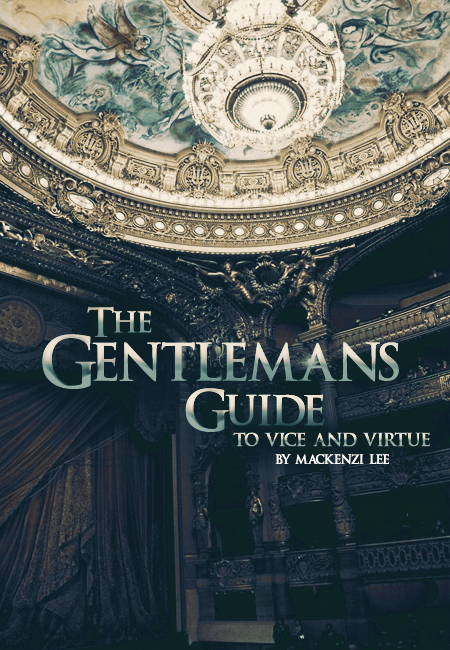
![cinemamonamour: Peter Bogdanovich about John Ford:He once said to me: [does gruff John Ford voice] cinemamonamour: Peter Bogdanovich about John Ford:He once said to me: [does gruff John Ford voice]](https://64.media.tumblr.com/41c5ded4f3044c9edb0d1b07416b7df4/tumblr_nby0ydZMEB1qefgdko1_500.jpg)












